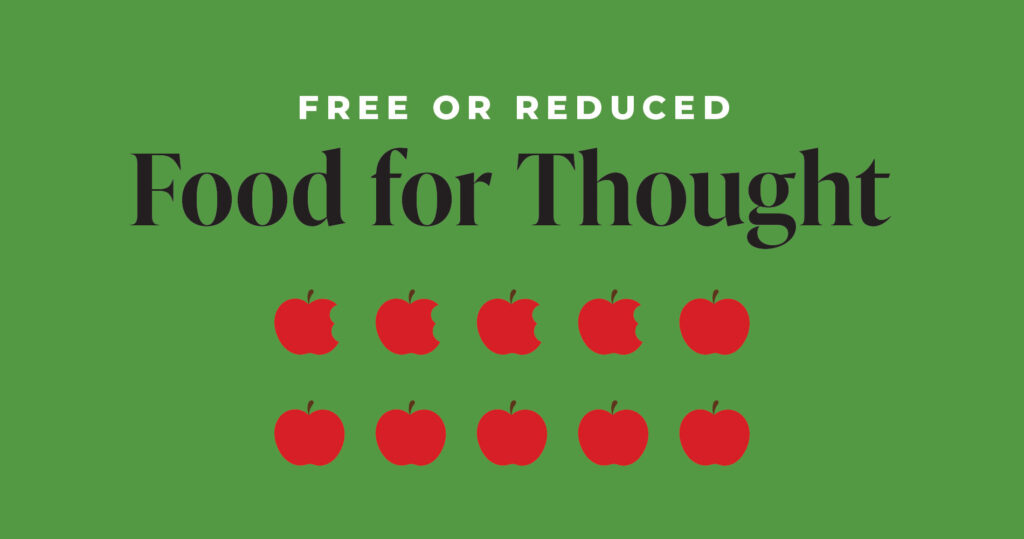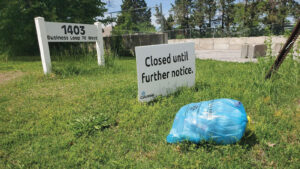A software glitch and the end of free meals for all feeds confusion.
Nearly four of every 10 students in Columbia Public Schools eat school lunch and breakfast for free or reduced cost according to the most recent report from the CPS nutrition services department.
With a total student enrollment of 19,021, the school district’s free and reduced meal eligibility summary report for February 2023 showed that 11,726 students district-wide — 62 percent of the student population — pay the full price for school breakfast and lunch. Thirty-eight percent of students, or 7,295, have qualified for free or reduced meal benefits.
The number of students with free and reduced lunch eligibility is possibly higher, says Laina Fullum, CPS’s nutrition services director, because some parents might not know they must reapply for the free and reduced meal program each school year. Others might think school breakfast and lunch is still free for all students as it was during the 2020 and 2021 school years.
“I think there is still a lot of misinformation out there and despite all our effort, some might think the meals are still free,” Laina says. “And they’re not this year.”
The free and reduced meal program eligibility is based on income. Household gross income must be 135 to 185 percent or less of the federal poverty level. For a two-person household, the annual maximum is $25,142; for a four-person household, the income maximum is $51,338. (Add $8,732 annually to determine eligibility for each additional person.)
Full-cost meal prices for grades K-5 are $2 for breakfast and $2.95 for lunch. The full price for grades 6-12 is $2 for breakfast and $3.15 for lunch. One additional milk or juice is 60 cents. The reduced price for eligible and approved students is 30 cents for breakfast and 40 cents for lunch.
After COVID: A Software Glitch
The world-changing COVID pandemic that began in the spring of 2020 led to myriad social and financial supports such as free school breakfast and lunch for all students when students returned to their classrooms later that year. The district notified parents before the beginning of this school year that the free meal benefit was no longer available unless families applied and were approved for free and reduced lunch.
“We blasted that out at the beginning of the year,” Laina explains. “I don’t think everyone quite understood what it meant. Parents are absolutely inundated with information.”
To complicate matters, the district switched and updated to a new software system in April 2022 that, at first, notified some parents that they owed a balance for their students’ meals when, in fact, they didn’t owe anything. Laina says the district’s internal records were correct, however.
“It was difficult to notify families because our information was correct, but some were notified that they owed money — but they didn’t,” she says. “That’s been very difficult for our families to understand. For us to even know who got them was challenging.”
In other instances, families that thought their students were still getting free meals at school were surprised when they were contacted that they did owe a balance.
“Only those families that filled out an application or were directly approved by the state” because of already qualifying for SNAP, or food stamps, or other social programs received the free or reduced benefit, Laina adds. “A lot of our families either forgot or didn’t understand what was going on.”
As a result, many families that would be eligible for the free and reduced-cost meal program did not apply for the current school year.
Free and Reduced Meal Economics
District-wide, 5,947 students were receiving free meals as of February, with another 1,348 qualifying for the reduced-cost price. Douglass High School has the highest percentage among Columbia’s high schools of students on the free and reduced meal program. Sixty-five percent of Douglass students (152 out of 233) receive the benefit. Among other high schools, Battle High School is the next highest with 46 percent (705 out of 1,542 students).
Blue Ridge Elementary and Derby Ridge Elementary, both at 73 percent free and reduced meal participation, are the CPS elementary schools with the highest level of free and reduced meal benefits. Lange Middle School at 63 percent (333 out of 526 students) and Oakland Middle School at 61 percent (323 out of 534 students) have the most participation among CPS middle schools.
Laina says it’s not fair or accurate to compare Columbia’s free and reduced meal numbers with other school districts because of widely varying economic factors. In the St. Louis area, for instance, some suburbs have a low number of free and reduced lunch-eligible students, while other schools have up to 100 percent free and reduced lunch and breakfast. Some of those varying economic factors are evident in different parts of Columbia.
“It’s all about whatever the community’s economics are and the businesses in those communities,” Laina explains.
She says the biggest message she can give to parents is to ‘give us a call’ if they don’t know if their children are eligible for free and reduced meals.
“If in doubt — if you’re not sure what your eligibility is — we would gladly answer your questions,” Laina explains. “We are happy to help any family needing help to fill out an application.” CPS nutrition services can be reached at 573-214-3480.
If a parent hasn’t received an approval letter, their student is not approved for the program. Benefits end at the end of each school year, requiring families to reapply.
“A lot of our families don’t understand that,” Laina says.
Out of the Red
As a result of COVID and students learning virtually from home, CPS nutrition services went into the red on its balance sheet as the staff was still getting paid. Laina says she’s proud of the fact that no one was laid off and that the shortfall was short-lived.
“It was not due to delinquent student accounts,” Laina says, explaining the economics of the picture. “We are not allowed by law to absorb debt in the district. This must be paid by general revenue if we have families who do not pay for their meals.”
She says the district was “in the black” going into the pandemic, and came out negative a year later. In the second year of the pandemic, federal subsidies boosted the account back onto the positive side.
Economic recovery money that poured in during and after the pandemic helped the department achieve a positive financial balance. The two-year waiver that made meals free “was lovely to be able to do for our families,” Laina says. “When it went away, I knew it was going to be a big deal for our families.”
Parents who were in school a generation or two ago might remember the lunchroom as a hub of connections with each other and the lunchroom staff. Laina says that’s still true, calling the cafeteria “a learning laboratory.”
“Our cooks, cashiers, and managers know just about every kid in school,” she adds. “There’s a lot of camaraderie. Our people really like kids.”
There is, perhaps, a noticeable difference from pre- to post-COVID. The size of the nutrition services staff has gone down from 165 to about 150, a somewhat ubiquitous phenomenon for all businesses.
“We have a shortage of people. I know everybody’s fatigued by that, but it’s still going on,” Laina says. She emphasizes that no one on staff was laid off during the pandemic.
“They’ve had to pull together and do a very difficult job. They’re very close now,” she says. “That’s a beautiful thing to see.”
The Cost of a Meal
Grades K-5
Breakfast: $2
Lunch: $2.95
Additional milk or juice: $0.60
Grades 6-12
Breakfast: $2
Lunch: $3.15
Additional milk: $0.60
Reduced Price K-12
Breakfast: $0.30
Lunch: $0.40
Menus available online at www.cpsk12.org/nutrition
Did You Know?
- Free and reduced meal benefits do not carry over from school year to school year. A new application must be completed each year. Applications can be submitted at any time during the school year.
- Students must select a full meal to receive any meal benefits (for free or reduced prices). Items sold as a la carte have an extra cost. A la carte items are singular items that do not make up a complete meal.
- All students receive the same meal offer regardless of account balance.
- All foods sold to students during the school day are under the scrutiny of USDA’s National School Lunch Program Regulations, which were created to promote high standards for all foods available to children.
- All meals with a complete number of items are federally subsidized and therefore monitored for minimum amounts on the student’s tray. Students must select three separate items for each meal. During breakfast, four items are offered and during lunch five items are offered. A fruit or a vegetable is a mandatory item. Without one, a student may be charged higher a la carte prices per item or sent back to get the missing item.
So, Who Qualifies?
- All children in households receiving one or more of the following eligibility criteria:
- Food Stamp Program/Supplemental Nutrition Assistance Program (SNAP) eligible
- Temporary Assistance for Needy Families (TANF) eligible
- Foster children: children who are the legal responsibility of a foster care agency or court
- Children participating in a Head Start program
- Homeless, runaway, or migrant children
- Household gross income meets 135 to 185 percent or less of the federal poverty level
Your children may qualify for free or reduced-price meals if your household income falls within the limits on the Federal Income Eligibility Guide. For a two-person household, the annual maximum is $25,142 (or $2,096 monthly and $484 weekly); for a four-person household, the income maximum is $51,338 ($4,279 monthly and $988 weekly). For each additional person, add $8,732 annually (or $728 monthly and $168 weekly) to determine eligibility.








